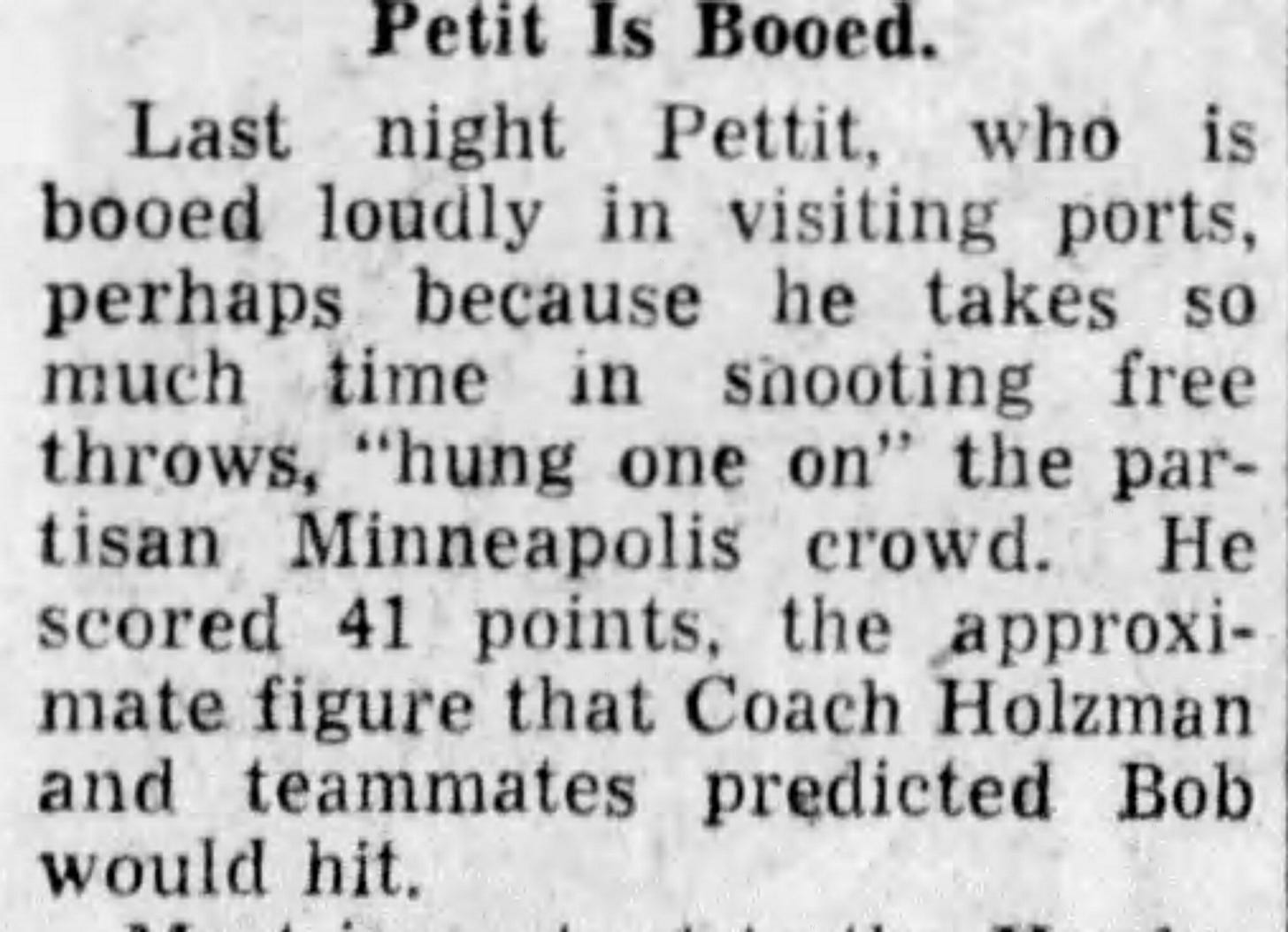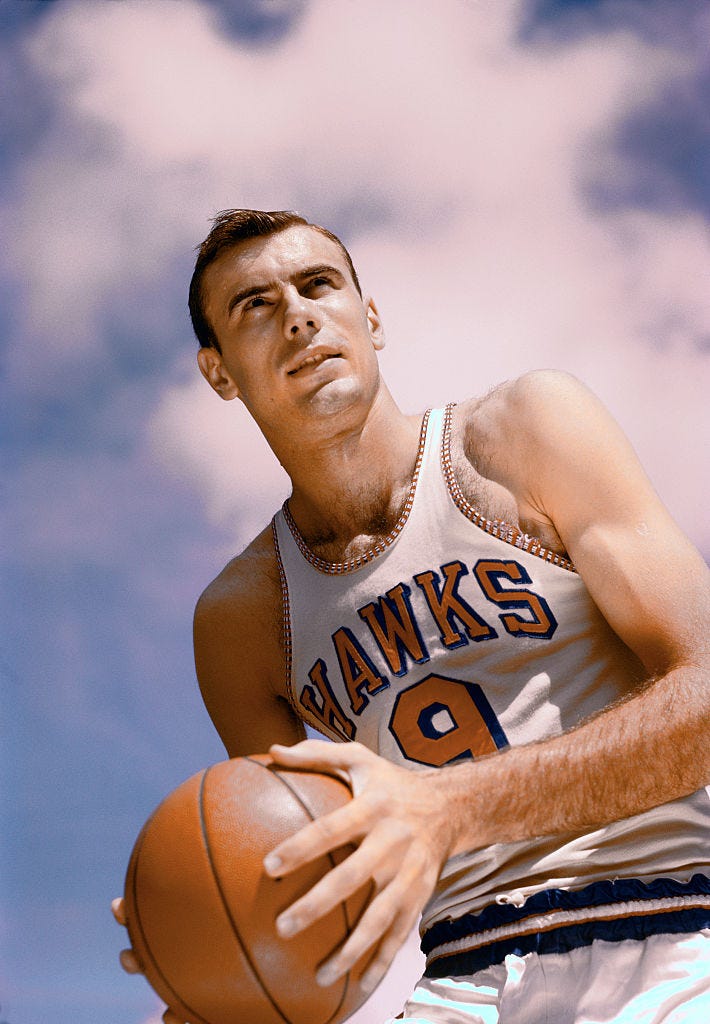This qualifies as one of the 72 “Greatest” Moments in NBA History
Recently, a certain ESPN writer that I typically enjoy has been besmirching the good name of Robert E. Lee Pettit, Jr. Hmm… okay, when you see the man’s full name questions get raised. No wonder Bob Pettit just goes by “Bob Pettit”.
Anyways, this besmirching has gone far enough and warrants a corrective ode in favor of Mr. Pettit and his contributions to the NBA.
PRELUDE: Bob Pettit was the first great jump-shooting big man in NBA history. Dolph Schayes had long-range attacks, but he was a student of the set shot. However, Pettit never fiddled with that old timey tool. Every great power forward or center since him who scores outside the paint with jumpers owes Pettit a debt…
*ahem* Dirk Nowitzki *ahem*
Also, Pettit’s field goal percentage, like all NBA players of the 1950s and 1960s, is low by today’s standards. Of course, that’s the price to be paid for using new techniques (the jump shot). Because the techniques were new, they weren’t perfected. But Pettit was well above the standard shooter of his era while scoring a ton of points. After all, he’s the only retired player in NBA history to average over 20 PPG for every season of his career.
Onward to some particular moments of greatness from Pettit, an inspiration for men everywhere who suffer from early baldness.
FIRSTLY, Bob Pettit was the NBA’s first MVP. As I’ve chronicled before, the first MVP should have been George Mikan, but the NBA was stupid and didn’t hand out MVP awards until the 1955-56 season. By that point, Mikan was retired and Pettit was in his second season averaging 25.7 PPG and 16.2 RPG. The PPG led the league and the RPG was behind only Maurice Stokes.
SECONDLY, Pettit was a boss in his first playoff series. The St. Louis Hawks finished with a 33-39 record that 1956 season. In the eight-team NBA, this was a serviceable record. Usually one team, maybe two, got a win total above or below the 30s in the 72-game schedule.
Facing off against the Minneapolis Lakers in a best-of-three series, the Hawks won Game 1 and then dropped Game 2 setting up a do-or-die Game 3 in Minnesota.
On the road, Pettit unleashed 41 points on 14-24 shooting to squeeze out a 116-115 win. 13 of his points came in the fourth quarter and his long free-throw line routine got on the nerves of disgruntled Laker fans. On this point, Pettit is one of only two players in NBA history to average over 10 FTAs per game (the other is Wilt Chamberlain) and made 76% of his attempts. That’ll boost the scoring stats.
In the interest of fairness, Pettit stunk in the next round versus the Fort Wayne Pistons. He averaged just 14.6 PPG on 31.3% shooting against the best defensive forward in the league, Mel Hutchins. That embarrasing episode would soon fade from memory.
THIRDLY, Pettit came back roaring for the 1957 playoffs. The Hawks swept the Lakers in the Western Division Finals, 3-0, behind Pettit’s 29.0 PPG and 13.3 RPG. His shooting was much improved connecting on 49.2% of his field goal attempts.
In the NBA Finals, Pettit’s shooting came back to earth because the Boston Celtics featuring Bill Russell were the opponent. Bob still put up 30.1 PPG and 18.3 RPG in the series, but shot just 38.8%. Still better than average for both teams (38% for StL; 36.9% for BOS) in the series.
In the double-overtime Game 1, Pettit scored 37 points giving St. Louis a surprising 125-123 win. In the double-overtime Game 7, Pettit scored 39 points but Boston pulled out the win, 125-123. Yes, same score, but different winner in those two games. In any case, Pettit had a super strong case to be Finals MVP despite not winning the series, albeit by the slimmest of margins.
Don’t worry, though, the NBA was still dumb and didn’t hand out any Finals MVP award until the 1969 season.
FOURTHLY, Pettit came back in 1958 ready to finally seize the NBA crown with all its glory.
Some folks like to point to Bill Russell missing time in that series with a bum ankle as some reason to belittle what Pettit did. I’ll just note that two of St. Louis’s four wins in the series came with Russell totally healthy. Now obviously Boston would have loved to have Bill for the whole series, but the Hawks had just lost to Boston in seven games in the previous Finals. These clubs were evenly matched in 1957 and 1958. And they’d play another seven-game Finals series in 1960.
Russell or no Russell, Pettit was a man on a mission in the decisive Game 6 of the ‘58 Finals to get his ring. (Wait, the NBA was still dumb and did not give out championship rings at this point).
The Blue Bomber dropped 50 points on the Celtics, still an NBA Finals record (tied by Giannis Antetokounmpo in 2021) for most points in a close-out game. And Pettit’s 50-piece came in a fashion that’s efficient for any era: 19-34 FGAs and 12-15 FTAs. Plus he added 19 rebounds.
In ultimate cajones factor fashion, Pettit scored 19 of the Hawks’ final 21 points in the fourth quarter of that game to seize the 110-109 victory and the only NBA title in Hawks franchise history.
Anyhoo, over the next few years Pettit would get another MVP award, get another scoring title, became the first NBA player with 20,000 career points, and also helped bring about a stronger NBA. Literally. He’s pretty much the first player to engage in regimented weight-lifting. After his rookie season where he got bumped around by stronger forwards, Pettit hit the weight room. He never became the strongest player in the league, but guys no longer beat up on him like a pinata.
Now if only Tim MacMahon would stop the elder abuse of an 89-year-old NBA legend.







As a boy growing up in New York in the 50s, I somehow adopted the St. Louis Hawks as “my team”. Until years later I did not know that Bob Pettit had been cut from his high school team twice, before his determination to achieve, practicing for hours, earned him a spot, and the rest is legendary. Although there was no television coverage of his 50 point championship clinching game (that I’m aware of), I DO have a CD of the radio broadcast of the fourth quarter, where he scored 19 of the Hawks’ 21 points in a one point win. I treasure that and was thrilled to see him appear at All-Star weekend, when the top 75 players of the NBA’s 75 years were honored.
Thanks for giving Mr. Pettit some much deserved love. Speaking of which, I appreciate that Pettit ALWAYS acknowledges how much better the game is now. Some of his peers (cough, Oscar) could stand to read a page out of that book. Or a whole damn chapter.